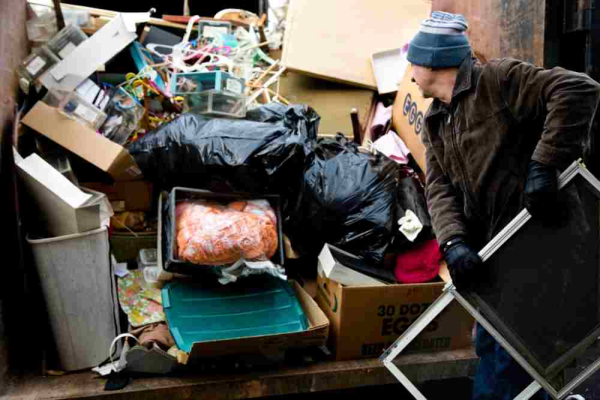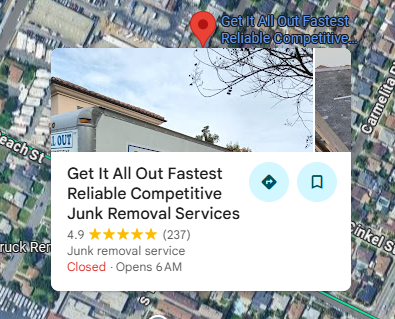How to Handle Dumpster Overflow Cleanup
Dumpster overflow poses health, environmental, and community risks if not addressed quickly. Overflow can attract pests, spread odors, contaminate soil, and scatter debris into neighborhoods.
Montebello, CA, United States, 1st Oct 2025, – When a dumpster begins to spill over with waste, it is rarely a simple issue. Overflow can occur when trash collection schedules do not align with how quickly waste is produced. Construction projects, home cleanouts, or business operations often create more debris than anticipated, leaving containers unable to contain it all. Beyond the inconvenience, an overflowing dumpster invites rodents, insects, and unpleasant odors that spread quickly through nearby areas.
Handling this situation requires both foresight and response. Identifying the reason behind the overflow is the first step, whether it comes from an underestimated project size or poor separation of recyclables. By knowing the cause, you can address not just the pile of waste but also the system that failed. Overflow cleanup is not only about tidying what has already spilled but also about preventing it from happening again in the near future.
Health Risks Linked to Overflowing Dumpsters
Overflowing dumpsters are more than just an eyesore. They create conditions that encourage bacteria to thrive, turning what seems like ordinary trash into a potential health hazard. Standing waste may attract pests that spread disease, and when rain mixes with garbage, runoff can contaminate soil or nearby drains. Anyone working near the pile without proper protection risks exposure to harmful materials.
Cleanup becomes urgent when waste piles too high, and safety precautions should never be overlooked. Gloves, masks, and sturdy footwear can prevent contact with contaminants while keeping sharp objects from causing injury. By treating dumpster overflow as a health concern rather than a simple mess, cleanup becomes an act of protection for both the environment and the people around it.
Environmental Concerns from Overflow
An overflowing dumpster has a way of extending its reach far beyond its container. Loose debris is easily carried by the wind, scattering plastic and paper across neighborhoods, parking lots, and waterways. Wildlife can mistake trash for food, leading to harmful consequences for local ecosystems. Overflow can also block storm drains, creating localized flooding when heavy rain arrives.
Cleaning up quickly helps limit environmental harm, but prevention plays an even bigger role. Proper waste segregation, responsible recycling, and timely hauling ensure that the container remains manageable. By respecting the environment in how we handle waste, overflow cleanup shifts from being a constant struggle to a rare, well-handled occurrence.
Practical Steps for Tackling Overflow Safely
Approaching dumpster overflow requires more than grabbing a few bags and tossing them aside. The safest way to begin is by separating what can be recycled, what must go to the landfill, and what might need special disposal. Large items should be removed first to create space for sorting smaller debris.
Once the pile is reduced, bagging loose trash and securing it helps prevent further spread. This is also the time to inspect for hazardous materials that require professional handling. Moving systematically through the cleanup ensures that nothing dangerous is overlooked and the area becomes safe again without leaving behind hidden risks.

Preventing Overflow During Busy Projects
During renovations, move-outs, or landscaping projects, dumpsters fill at an astonishing pace. It is common to underestimate just how much space debris will occupy, which is often the root cause of overflow. Scheduling a container that is slightly larger than expected needs can make the difference between a smooth cleanup and a messy overflow.
Equally important is pacing disposal. Spreading out loading times instead of dumping everything at once prevents compaction issues that reduce usable space. Regular checks throughout a project give you the chance to address a filling container before it tips into overflow territory. In this way, prevention becomes part of the project planning rather than an afterthought.
The Role of Professional Services in Overflow Cleanup
When overflow has already occurred, handling it alone can feel overwhelming. Large piles of debris often include bulky items, heavy materials, or hazardous components that are not easy for one person to manage. Professional services bring not only the labor but also the equipment to handle these challenges safely.
Beyond the immediate cleanup, professionals understand disposal regulations and know how to direct waste to the proper facilities. By turning the task over to experts, you not only resolve the visible problem but also ensure compliance with local laws. This level of thoroughness reduces the chances of recurring overflow issues.
Community Impact of Overflowing Dumpsters
Overflowing dumpsters do not just affect the property where they sit. Neighborhoods quickly notice the smell, scattered trash, and appearance of neglect. Businesses may find that customers are deterred by an unsightly dumpster area, while residential communities may experience rising frustration from neighbors dealing with the mess.
Taking swift action to clean and contain overflow protects community pride and prevents small issues from escalating into disputes. A clean and organized dumpster area reflects respect for those who live and work nearby. Cleanup, in this sense, becomes not only about managing waste but about maintaining harmony in shared spaces.
Seasonal Challenges in Managing Overflow
Dumpster overflow rarely happens evenly throughout the year. Certain seasons have a way of creating sudden spikes in waste production, and those patterns often catch property owners or project managers off guard. Spring is one of the most common culprits, with households engaging in deep cleanouts, yard projects, and garage decluttering that produce more trash than usual. Around the holidays, another surge arrives, with packaging, decorations, and discarded household goods filling containers faster than pickup schedules can keep up. Construction-heavy months also see dumpsters pushed beyond their limits, as demolition debris and building scraps pile in rapidly.
The good news is that these challenges can be anticipated. Planning for overflow by arranging extra pickups during seasonal peaks helps keep waste under control. Temporary containers can also ease the load during times when a single dumpster is not enough. Seasonal awareness changes waste management from reaction to preparation, ensuring that no busy period results in overflowing piles. Instead of being surprised by predictable surges, property owners can stay ahead of them with a proactive approach that keeps their environment clean and organized.
Reducing Overflow Through Smarter Waste Habits
Not every case of overflow comes from too much waste. Sometimes, the real issue is how the trash is placed inside the dumpster. Boxes that are left intact take up space unnecessarily, while bulky items that could be compacted create uneven layers of waste. Tossing materials in without any thought to arrangement quickly makes the container appear full, even when plenty of space remains unused. Small adjustments, like breaking down cardboard or flattening large plastics, can make a significant difference in how much a dumpster can hold.
Teaching proper disposal habits goes a long way in preventing overflow. Whether at a construction site, a business property, or a residential setting, simple guidelines can help maximize capacity. Recycling also plays an important role, since diverting paper, metal, and glass away from the dumpster reduces the overall volume of trash inside. These small steps turn one container into a far more effective solution. By building smarter waste habits into everyday routines, cleanup becomes easier, overflow is reduced, and dumpsters remain manageable rather than a constant source of frustration.
Signs It Is Time for Extra Help
There comes a point when even the best planning cannot prevent dumpster overflow. A container that fills up within days of being emptied or one that regularly causes trash to spill over is signaling a bigger issue. Property owners often try to adjust by ordering larger dumpsters or tweaking pickup schedules, but when the cycle continues, it becomes clear that outside support is needed. Ignoring these warning signs leads to repeated messes, extra work, and potential health and safety risks that could have been avoided.
Professional assistance provides relief on two levels. First, the overflow itself is managed quickly and thoroughly, restoring the area to a clean, usable state. Second, experienced teams can analyze why the problem is occurring and suggest long-term solutions tailored to the situation. Instead of treating overflow as a never-ending struggle, extra help transforms waste management into a process that works smoothly. Knowing when to call in support is not a sign of defeat but a practical choice that saves time, reduces stress, and keeps properties functioning as they should.
Neighborhoods in and around Bell, CA
When searching for junk removal near me, it helps to know which neighborhoods in Bell and surrounding areas often rely on these services. Here are some of the notable spots:
- Downtown Bell – The city’s hub, home to local shops, eateries, and community centers. Businesses here often need junk removal after renovations or upgrades.
- Bandini Neighborhood – A largely residential area where many families call home. House cleanouts and appliance removal are common requests here.
- Bell Gardens Border Area – Close to Bell Gardens, this region sees plenty of shared community activity, where junk removal helps with property cleanups.
- Commerce Adjacent – With many warehouses and industrial zones nearby, this area benefits from bulk junk removal, including pallets, scrap, and old equipment.
- Florence Avenue Corridor – A busy stretch with a mix of residential and commercial spaces that frequently rely on junk hauling services to manage waste efficiently.
- Southern Bell Neighborhoods – Featuring more compact housing and rental properties, making junk removal vital during tenant turnovers and property maintenance.
- Gage Avenue Area – A popular residential district where residents often need assistance with yard waste, old furniture, and seasonal cleanouts.
Conclusion
Dumpster overflow is never just about a messy container. It can affect health, the environment, and even community relationships if ignored. Knowing how to approach cleanup and prevent recurrence is key to maintaining safe and pleasant surroundings. From understanding the root causes to adopting smarter waste habits, every step plays a role in ensuring that overflow does not become a constant concern.
When the situation calls for dependable junk removal assistance, Get It All Out Junk Removal in Montebello, California, is ready to help. Their team brings the experience, equipment, and care needed to handle overflow and keep properties looking their best. For immediate support, reach out at 323-900-5069 and take the stress out of managing waste before it spreads beyond control.
Get It All Out Junk Removal Services
717 S Taylor Ave, Montebello, CA 90640, United States
3233816235
https://getitalloutjunkla.com/
Company Details
Organization: Get It All Out Junk Removal Services
Contact Person: Get It All Out Junk Removal Services
Website: https://getitalloutjunkla.com/
Email: Send Email
Contact Number: +13233816235
Address: 717 S Taylor Ave, Montebello, CA 90640, United States
City: Montebello
State: CA
Country: United States
Release Id: 01102534769

